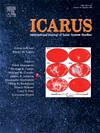Layered remnant deposits in Hellas Planitia, Mars as the remains of ancient ice mounds
IF 2.5
2区 物理与天体物理
Q2 ASTRONOMY & ASTROPHYSICS
引用次数: 0
Abstract
Hellas Planitia is the site of many icy features in craters whose formation mechanisms offer insights into the climate processes of Mars. Layered remnant deposits (LRD) appear as crater deposits with distinct layers and have an unclear formation because of their frequent existence in the southern half of craters. We create an inventory of LRDs within Hellas Planitia using Thermal Emission Imaging System (THEMIS), Context Camera (CTX), and HiRISE images when available to measure key characteristics of LRDs and their host crater. We find 245 LRDs. Based on trends in our inventory, we propose LRDs result from old, crater-filling ice mounds that had preferential sublimation on the northern side leaving the present-day remnant in the southern portion of the crater. Understanding the formation of LRDs provides valuable insights into the broader narrative of Mars' climatic history, offering clues about past environmental conditions in the planet's Amazonian era.
在Hellas Planitia的层状残余沉积物,火星作为古代冰丘的遗迹
Hellas Planitia是许多冰状陨石坑的所在地,这些陨石坑的形成机制为了解火星的气候过程提供了线索。层状残余物沉积物(LRD)由于经常存在于陨石坑的南半部,以层状沉积物的形式出现,形成不明确。我们使用热发射成像系统(THEMIS)、背景相机(CTX)和HiRISE图像在可用的情况下创建了Hellas Planitia内lld的清单,以测量lld及其宿主陨石坑的关键特征。我们找到245个lrd。根据我们的库存趋势,我们提出lrd是由古老的陨石坑填充冰丘造成的,这些冰丘在陨石坑的北侧有优先升华,在陨石坑的南部留下了今天的残留物。了解lrd的形成为更广泛地了解火星气候历史提供了有价值的见解,为地球亚马逊时代过去的环境状况提供了线索。
本文章由计算机程序翻译,如有差异,请以英文原文为准。
求助全文
约1分钟内获得全文
求助全文
来源期刊

Icarus
地学天文-天文与天体物理
CiteScore
6.30
自引率
18.80%
发文量
356
审稿时长
2-4 weeks
期刊介绍:
Icarus is devoted to the publication of original contributions in the field of Solar System studies. Manuscripts reporting the results of new research - observational, experimental, or theoretical - concerning the astronomy, geology, meteorology, physics, chemistry, biology, and other scientific aspects of our Solar System or extrasolar systems are welcome. The journal generally does not publish papers devoted exclusively to the Sun, the Earth, celestial mechanics, meteoritics, or astrophysics. Icarus does not publish papers that provide "improved" versions of Bode''s law, or other numerical relations, without a sound physical basis. Icarus does not publish meeting announcements or general notices. Reviews, historical papers, and manuscripts describing spacecraft instrumentation may be considered, but only with prior approval of the editor. An entire issue of the journal is occasionally devoted to a single subject, usually arising from a conference on the same topic. The language of publication is English. American or British usage is accepted, but not a mixture of these.
 求助内容:
求助内容: 应助结果提醒方式:
应助结果提醒方式:


